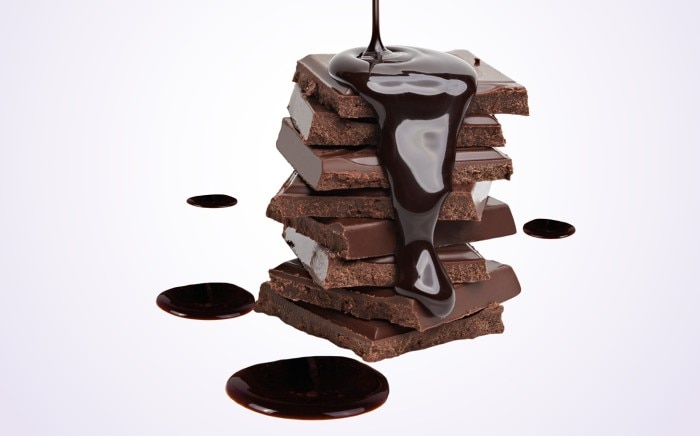MENU
US | USD
US | USD
-
- Benchtop Centrifuges
- Floor-Standing Centrifuges
- Refrigerated Centrifuges
- Microcentrifuges
- Multipurpose Centrifuges
- High-Speed Centrifuges
- Ultracentrifuges
- Concentrator
- High-Speed and Ultracentrifugation Consumables
- Accessories
- Tubes
- Plates
- Device Management Software
- Sample and Information Management
No results found
Search Suggestions

An Inherent Undulgence
Beyond Science
- Food & Beverages
- Off the Bench
- Off the Bench
- Inspiring Science
Even from a scientific perspective, chocolate has a lot to offer – after all, this treat is chock-full of surprising facts. We have compiled five.
Flavoring Agent Identified
Chocolate that tastes of potato chips, cucumber or boiled meat – a rather far-fetched and unappetizing thought. However, this is exactly what the roughly 600 aromas contained within a cocoa bean taste like: they are not at all chocolatey but highly individual. This finding is not new: as early as 2011, Peter Schieberle, then employed at the German Research Institute for Food Chemistry in Munich, together with his team, isolated the basic building blocks of the classic chocolate aroma. The result: only 25 of the several hundred aromas are needed to produce the typical cocoa flavor. It is the combination of these aromas that paves the way to the unique chocolate experience. Schieberle’s discoveries thus laid the foundation for the targeted alteration and refinement of chocolate varieties.
Healthier Than Expected
There is a persistent rumor that those who want to support their health and stay slim should stay away from chocolate. Researchers at the University of Aberdeen, in the group of Chun Shing Kwok, have observed that test subjects who ate up to 100 grams of dark chocolate per day suffered less from heart disease than those who did not indulge. Today, many more beneficial qualities are known. The cocoa bean is considered one of the largest natural sources of magnesium among all foods; it contains antioxidants which protect the body from free radicals; and its consumption raises the “good” cholesterol in the blood. The same rule applies here: the darker the chocolate, the better its quality.
Happiness in a Cocoa Bean
Eating chocolate improves one’s mood. This is not entirely due to its flavor: nutritional physician Johannes Georg Wechsler, Head of the Center for Food Medicine and Prevention (ZEP), credits chocolate with a mood-enhancing effect. Chocolate contains the amino acid tryptophan which, in turn, ensures that the happiness hormone serotonin is produced inside the body. It is, however, unclear whether the doses of these ingredients are indeed high enough to influence our mood in a positive way. According to Wechsler, chocolate not only elevates our mood in the short-term, but it can also have anti-depressive effects. That being said, in the case of serious mental illness, it is of course not considered appropriate therapy.
Effective Stimulant
Chocolate provides comfort in times of heartache; it motivates during stressful phases at work or in school, and according to a study out of the UK, its effect is even akin to that of doping. A team of researchers led by Rishikesh Kankesh Patel at Kingston University wanted to know how the consumption of chocolate would affect athletic performance. To this end, cyclists mounted their bikes and rode for a period of two minutes at moderate speed. Those who had consumed 40 grams of dark chocolate daily in the two weeks prior to this experiment covered farther distances than the control group. Patel’s explanation: due to its content of flavanols – secondary plant chemicals contained within the cocoa bean – dark chocolate will expand the blood vessels and thus reduce oxygen consumption during athletic activities in a measurable manner. Improved performance without doping – another item on the list of benefits of chocolate.
Cocoa Without the Plant
As tempting as chocolate may be, we have an uneasy feeling as sugar and fat-laden chocolate enters our shopping cart – and its climate footprint also leaves much to be desired. For a bar of chocolate to make it to the checkout, rain forest must give way to the cultivation of cocoa beans. Furthermore, long transport routes to their destinations contribute to climate stress. There may be light at the end of the tunnel: Regine Eibl and Tilo Hühn of Zurich University of Applied Sciences have succeeded in growing cocoa from the seeds of a fruit in the laboratory and use this to make chocolate. Their method is called “cellular agriculture”, where natural processes are imitated in a bioreactor. “You can make as much chocolate as you like”, says Tilo Hühn. Entirely without sunlight, soil, pesticides and fertilizer. At this time, however, climate-conscious consumers are asked to be patient: today, a 100-gram bar of chocolate made in the lab would cost close to 200 euros. Read more
Read less

